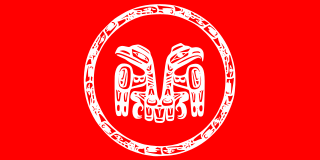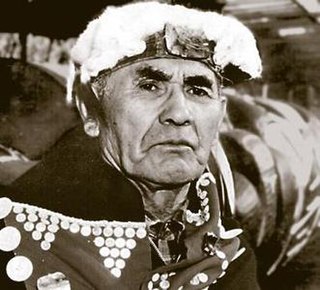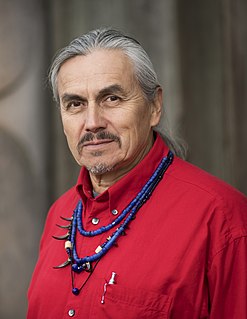Related Research Articles

William Ronald Reid Jr. (Haida) was a Canadian artist whose works include jewelry, sculpture, screen-printing, and paintings. Producing over one thousand original works during his fifty-year career, Reid is regarded as one of the most significant Northwest Coast artists of the late twentieth century.

Haida are an indigenous group who have traditionally occupied Haida Gwaii, an archipelago just off the coast of British Columbia, Canada, for at least 12,500 years.

Totem poles are monumental carvings, a type of Northwest Coast art, consisting of poles, posts or pillars, carved with symbols or figures. They are usually made from large trees, mostly western red cedar, by First Nations and Indigenous peoples of the Pacific Northwest Coast including northern Northwest Coast Haida, Tlingit, and Tsimshian communities in Southeast Alaska and British Columbia, Kwakwaka'wakw and Nuu-chah-nulth communities in southern British Columbia, and the Coast Salish communities in Washington and British Columbia.
Roy Henry Vickers, is a Grammy Award nominated Canadian First Nations artist. He owns and operates a gallery in Tofino, British Columbia.
Robert Charles Davidson, OC, OBC, is a Canadian artist of Haida heritage. Davidson's Haida name is G̲uud San Glans, which means "Eagle of the Dawn". He is a leading figure in the renaissance of Haida art and culture. He lives in White Rock, British Columbia.
Coast Mountain College (CMTN) is an accredited, publicly-funded post-secondary educational institution that serves the communities of British Columbia's northwest region. CMTN offers field schools, college access, trades, university credit, health and human services programs. The college is a member of the University of the Arctic network, and Colleges and Institutes Canada (CiCan).

Dempsey Bob, OC is a Northwest Coast woodcarver and sculptor from British Columbia, Canada, who is of Tahltan and Tlingit First Nations descent. He was born in the Tahltan village of Telegraph Creek on the Stikine River in northwestern B.C., and is of the Wolf clan.
Freda Diesing was a Haida woman of the Sadsugohilanes Clan, one of very few female carvers of Northwest Coast totem poles and a member of the Council of the Haida Nation of British Columbia, Canada. Her Haida name is Skil Kew Wat, meaning "magical little woman."

Charles Edenshaw was a Haida artist from Haida Gwaii, British Columbia. He is known for his woodcarving, argillite carving, jewellery, and painting. His style was known for its originality and innovative narrative forms, created while adhering to the principles of Formline art characteristic of Haida art. In 1902, the ethnographer and collector Charles F. Newcombe called Edenshaw “the best carver in wood and stone now living.”

Northwest Coast art is the term commonly applied to a style of art created primarily by artists from Tlingit, Haida, Heiltsuk, Nuxalk, Tsimshian, Kwakwaka'wakw, Nuu-chah-nulth and other First Nations and Native American tribes of the Northwest Coast of North America, from pre-European-contact times up to the present.

Chief Mungo Martin or Nakapenkem, Datsa, was an important figure in Northwest Coast style art, specifically that of the Kwakwaka'wakw Aboriginal people who live in the area of British Columbia and Vancouver Island. He was a major contributor to Kwakwaka'wakw art, especially in the realm of wood sculpture and painting. He was also known as a singer and songwriter.

Joe David is a Nuu-chah-nulth artist, a member of the Tla-o-qui-aht Band of the Nuu-chah-nulth people, also formally "adopted" into the Haida people, whose work is identified with the contemporary Northwest Coast art movement; among his close associates are teacher and art historian Bill Holm, Duane Pasco, and his cousin Ron Hamilton. He is also a singer of traditional Nuu-chah-nulth songs, and has a strong interest in shamanic traditions, both those from his own culture and from others.

A button blanket is wool blanket embellished with mother-of-pearl buttons, created by Northwest Coastal tribes, that is worn for ceremonial purposes.
Terry Starr is a Tsimshian Nation artist from the Gispaxlo'ots tribe of British Columbia, Canada.
Primrose Adams was a Canadian First Nations artist and member of the Raven Clan from the Haida nation. She wove hats and baskets in the Haida method and is most notable for her spruce root basketry, which involves working in the traditional manner of collecting and dyeing her own spruce root. Adams died in January 2020.
Doug Cranmer (1927–2006), also known as Pal'nakwala Wakas and Kesu', was a Kwakwaka'wakw carver and artist as well as a 'Namgis chief. Cranmer was a significant figure in the Northwest Coast art movement, both in its traditional form and in a modern contemporary form that he created and developed.

Beau Dick was a Kwakwaka'wakw Northwest Coast artist and Chief who lived and worked in Alert Bay, British Columbia, Canada. He was a contemporary artist, activist and hereditary Chief from the Namgis First Nation. Dick was an award winning artist with an extensive national and international exhibition history.

Jim Hart is a Canadian and Haida artist and a chief of the Haida Nation.
Simon Charlie or Hwunumetse' (1919–2005) was a Canadian totem sculptor of the Cowichan Tribes (Quw'utsun) of the Coast Salish nation, known for his wood carvings. He was born in Koksilah, on Vancouver Island, close to Duncan, British Columbia.

Douglas Reynolds Gallery is an art gallery in Vancouver, British Columbia. It is located in the Business Improvement Area of South Granville. The gallery was founded in 1995 by Douglas Reynolds.
References
- 1 2 3 "Phil Gray". Lattimer Gallery. Retrieved November 28, 2017.
- 1 2 Dawkins, Alex (28 Jan 2014). "Cedar Chic: Northwest Coast Native Décor: Pop-culture with an Indigenous twist". Urban Native Magazine. Archived from the original on June 2, 2016. Retrieved November 28, 2017.
- ↑ "BC First Nations' artists honoured with awards". British Columbia Achievement Foundation. November 28, 2014. Retrieved November 28, 2017.
- ↑ "2014 BC First Nations Art Awards Announced". British Columbia Achievement Foundation. 2014. Retrieved November 28, 2017.
- 1 2 Tepper, Leslie (2014). The Grand Hall: First Peoples of Canada's Northwest Coast. Library and Archives Canada. p. 48. ISBN 9780660202792.